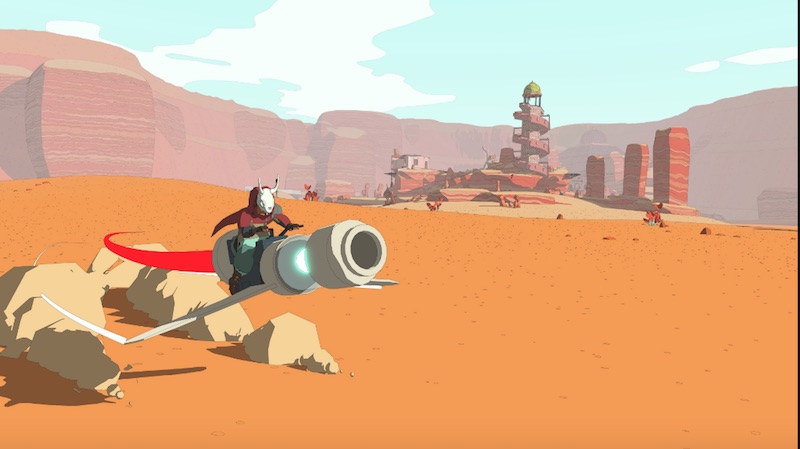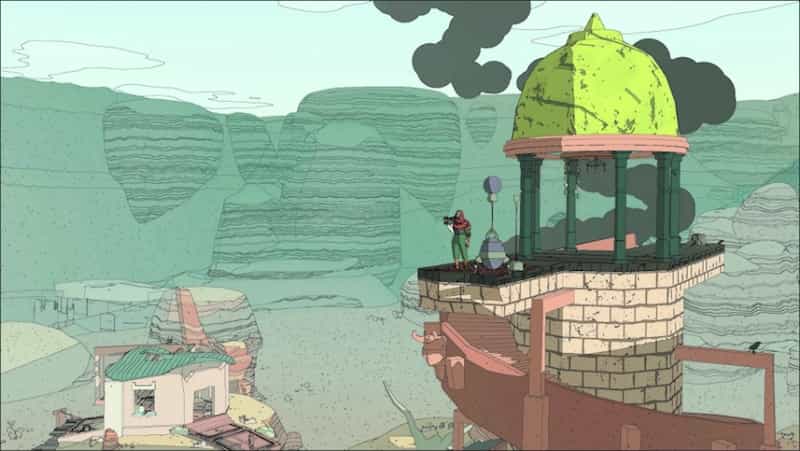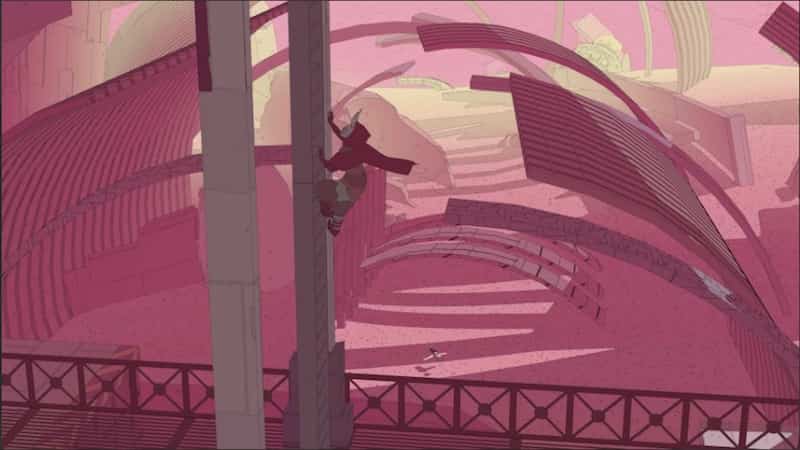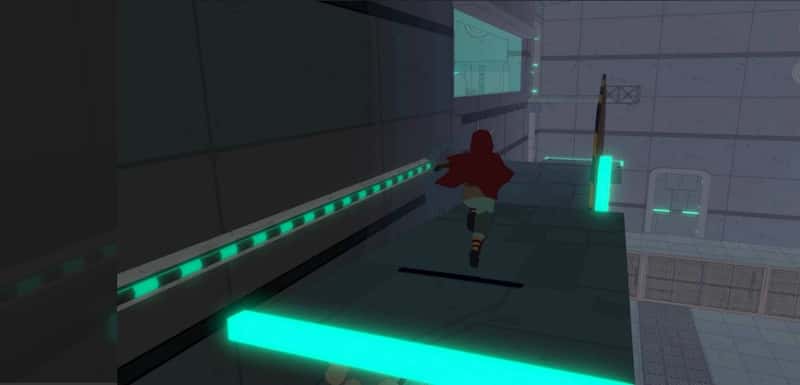Sable PS5 Review. Shedworks’ visually-arresting RPG finally heads to PlayStation. Was the wait worthwhile? Find out in PlayStation Universe’s PS5 review.
I play a lot of horror games, so I find it a bit of a treat when I get to play something a bit more leisurely now and again. Sable begins in such an incredibly chilled out and comfy way that I almost felt like putting the fire on and getting a nice cup of hot chocolate. I know that sounds odd for a game that largely takes place in a desert region, but it’s not the atmosphere.
It’s the way the game reminds me of a lazy Winter Sunday watching some adventure on a distant world whilst enveloped in the warmth of a roaring fire. I suppose what I’m getting at is Sable makes me feel like I’m a young ‘un stumbling upon some cult classic adventure film for the first time. A mixture of strangeness and wonder that imprints it on the memory for years to come.
So yeah, the short of it is, I quite like Sable.
Sable Review (PS5) – Shedworks’ Rotoscoped Rite of Passage Adventure is Spellbinding
Sable Offers A Personal Journey With A Distinct Visual Style
The game is about the titular Sable, a young woman who is about to embark upon a rite of passage known as the Gliding. This journey take us along as Sable navigates vast desert terrain on her hoverbike and visits the people and places that call it home. It sits somewhere between the nomadic nature of Journey and the faux-Zelda vibes of something like Okami. While I don’t necessarily think Sable gets all that close to matching those comparisons, it’s closer than I’ve seen any game manage in the years since either was released.
Sable’s sandy voyage feels personal because Shedworks puts a lot of effort into setting up her story. We drop into it in the buildup to her Gliding. To begin with that’s just chatting to the few people that live in her village that sits atop a rock in a desert canyon.
Soon after though, Sable and the player have to find the parts for what will be her own unique hoverbike whilst receiving sagely life lessons and heartfelt goodbyes along the way. It’s an admittedly slow start that is typical of this kind of game, but it’s so important in establishing the culture of this world.
It also helps to get your eyes used to Sable’s distinct visual style. It’s a cel-shading/rotoscope style that is a great way to get people staring at it, but that comes with a slightly discombobulating side effect. It looks really odd at first.
Have you watched Spider-Man: Into The Spider-Verse? If not, why not? It’s a fantastically-made film even if you can’t stand comic book films. If you have, I put forward a different question. Did the deliberately jerky animation style put the fear in you the first time you watched it?
It ends up being the key to that film’s spectacle, but in those opening trailers and the first 20 minutes or so of the initial viewing of the film itself, it’s jarring in more ways than one. But the more you see it, the easier it becomes to adjust to it and appreciate the work it puts into making the final product feel so distinct.
A Simple Game With A Certain Elegance To Its Movement
Sable is like that, There’s an undeniable beauty to the game’s visuals and Dune/Nausicaä aesthetic, but it’ll be hard going to begin with. I felt this way with the recent horror game Saturnalia, which also employed a rotoscoping style, and the common thread in these examples is that the disorientation does fade and the true beauty of the style shines on through.
What’s not especially helpful to Sable’s use of it is that after certain missions and area transitions, the game hitches momentarily, and having the visual effect zig when it’s supposed to be zagging made me feel more nauseous than Nausicaä. Again, it’s something I got used to, but it’s the part I wish I hadn’t had to.
For what it’s worth, the visual style is a huge part of what makes playing Sable such a delight. Whether I was traversing ancient ruins or sailing the sands, there was something bewitching about seeing Sable in action. Sure, it’s a relatively simple game to get to grips with, but there’s an elegance to movement that you wouldn’t necessarily associate with its staccato movement.
Sable herself navigates the world in typical open world fashion. She’s able to jump and climb, with an energy bar determining just how long she can climb sheer surfaces for, and environment interaction is pretty uniform throughout, but Shedworks’ design ensured I was an engaged, smaller part of a wider unknown world.
The hoverbike is a standout for me. Initially, a villager loans Sable their rickety rustbucket of an old bike to do some jobs before she gets her own, and it’s a great way to introduce this aspect of the game. The bikes are machines, but the villagers believe they house personal spirits, making them beasts that need to be tamed and owned.
Nowhere does that feel as true as the moment I sat on the old donkey of a bike and had Sable careening all over the dunes in a bumbling, slow fashion. It’s akin to how Red Dead teaches you to ride a horse.
Sable’s Hoverbike Is A Real Highlight
Then, after the opening act is done and Sable finally gets that new hoverbike, it’s a thrilling shift of pace. It still behaves like a beast you need to keep onside and be respectful of, but it moves so much more gracefully.
Credit to Shedworks, it really does manage to translate the concept of these low-flying machines as the natural successor to horseback riding, from the control to the writing that surrounds talk of them. The DualSense puts in some work too as it enhances the weight and strength of the machines with its rumble and adaptive trigger pressure.
Once Sable gets out into the world, the relatively stuffy confines of the opening are blown away and replaced with a grander sense of adventure that evokes the very games Shedworks seeks to pay tribute to. It seems remarkable to call Sable a throwback open world game, but it really is. The biggest compliment you could pay Shedworks is to call this a lost relic of the PS2/GameCube era of gaming. A game where conflict isn’t the point, but you still feel like you’re up against the world.
The downside there is it tends to seem a touch stretched out for the sake of playtime in the same way some of those games did, but like the better examples, Sable tries to give these quieter moments some weight, and doesn’t outstay its welcome if you choose to largely focus on the story as it clocks in at around eight or so hours.
There’s a natural dilution of interest in a game that’s already been available elsewhere for a while that comes from missing the launch window reviews and build up, but the flipside of this is that games like Sable get to be approached from a fresh perspective free of the chatter of the original launch. I’m glad I got that experience with Sable.
Sable is now available for PS5, PC, Xbox Series X/S and Xbox One.
Review code kindly provided by publisher.



